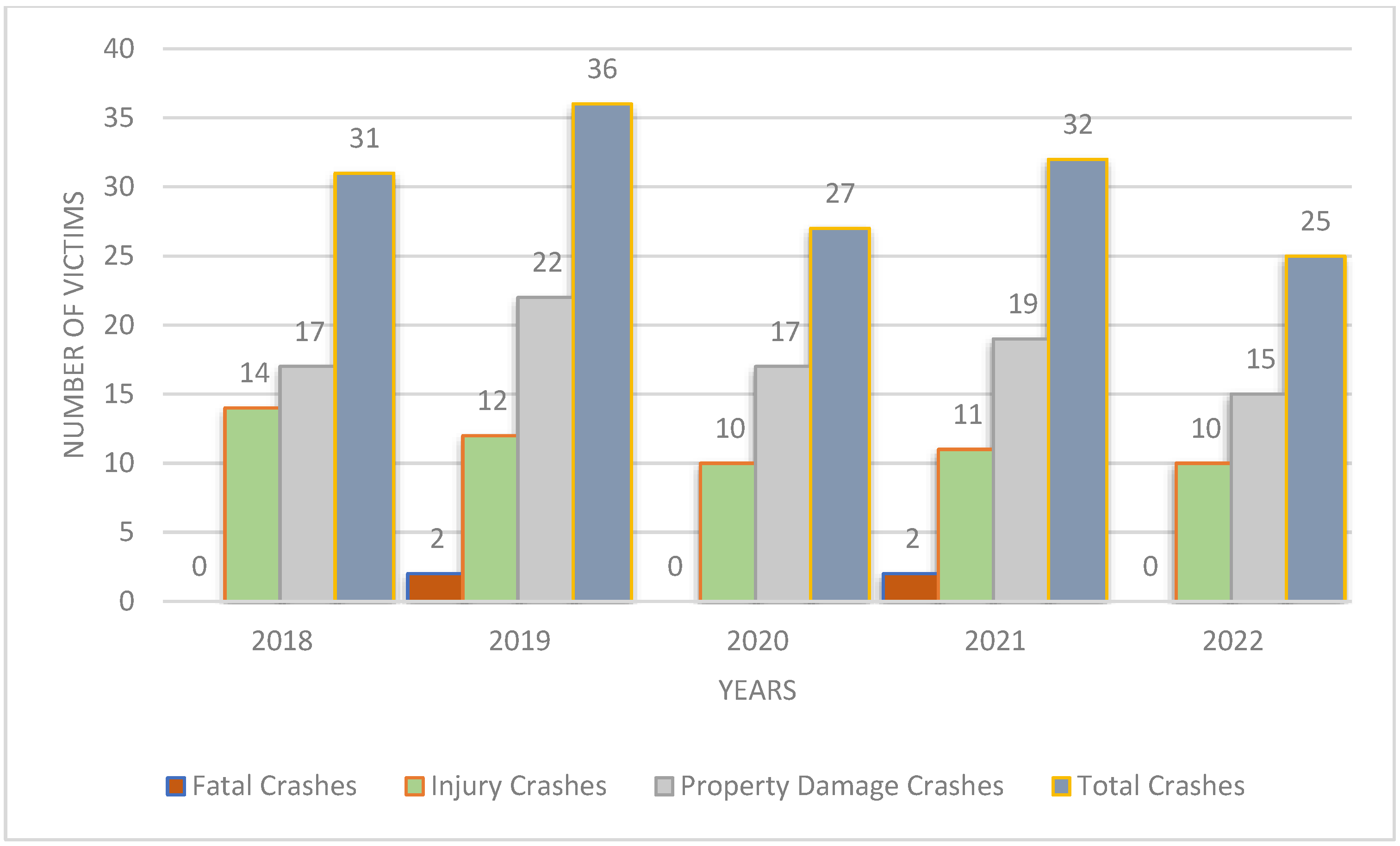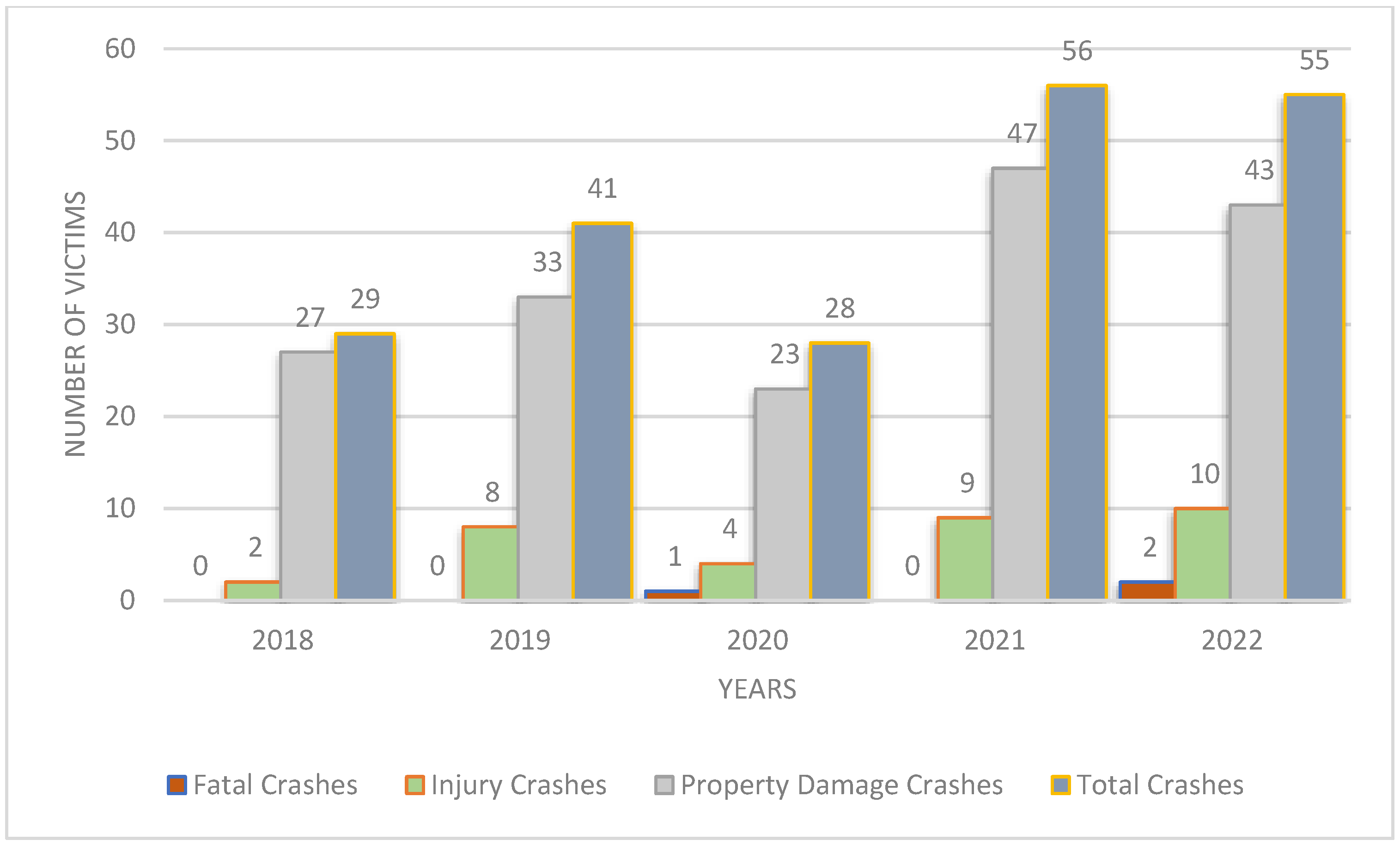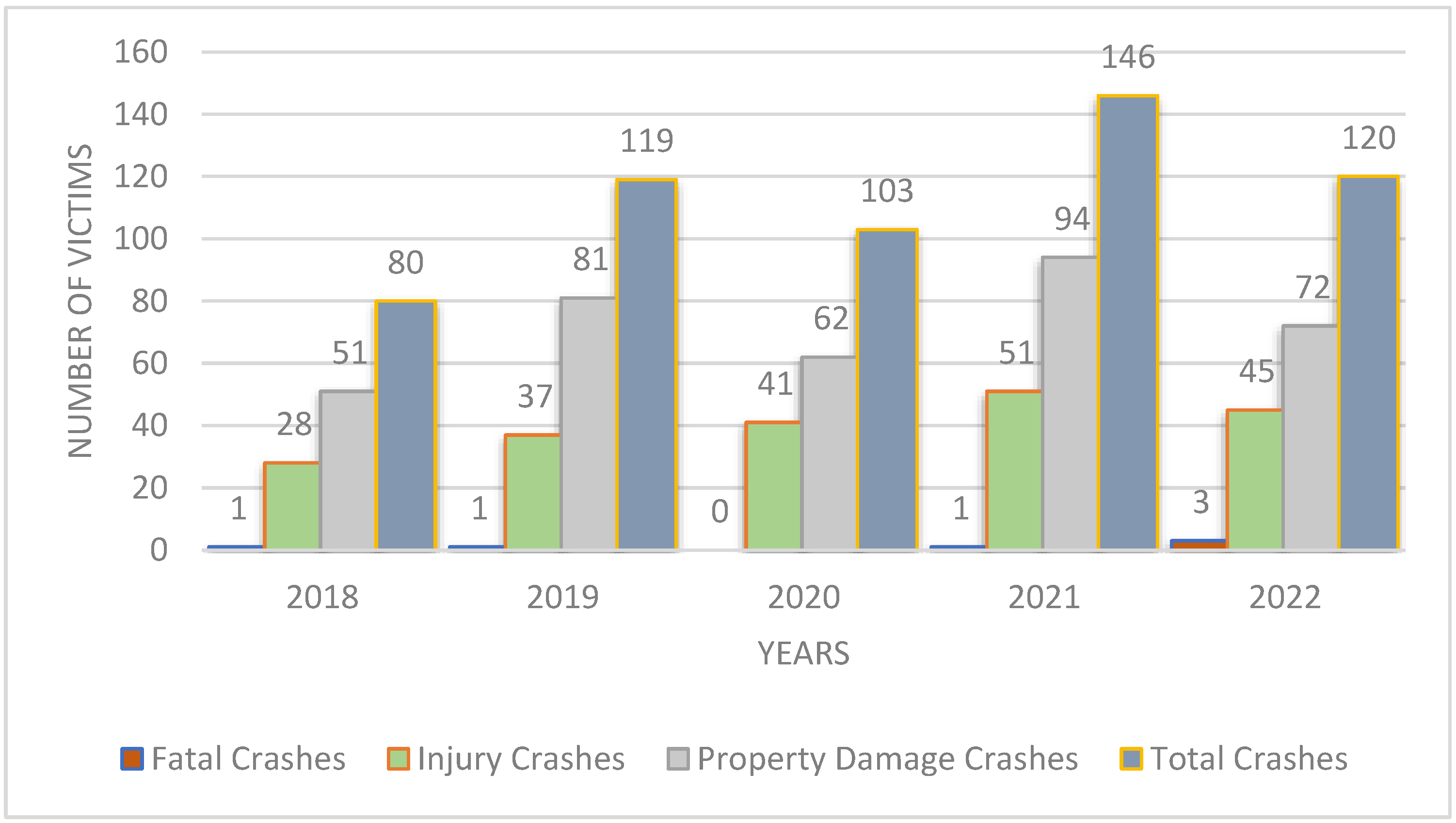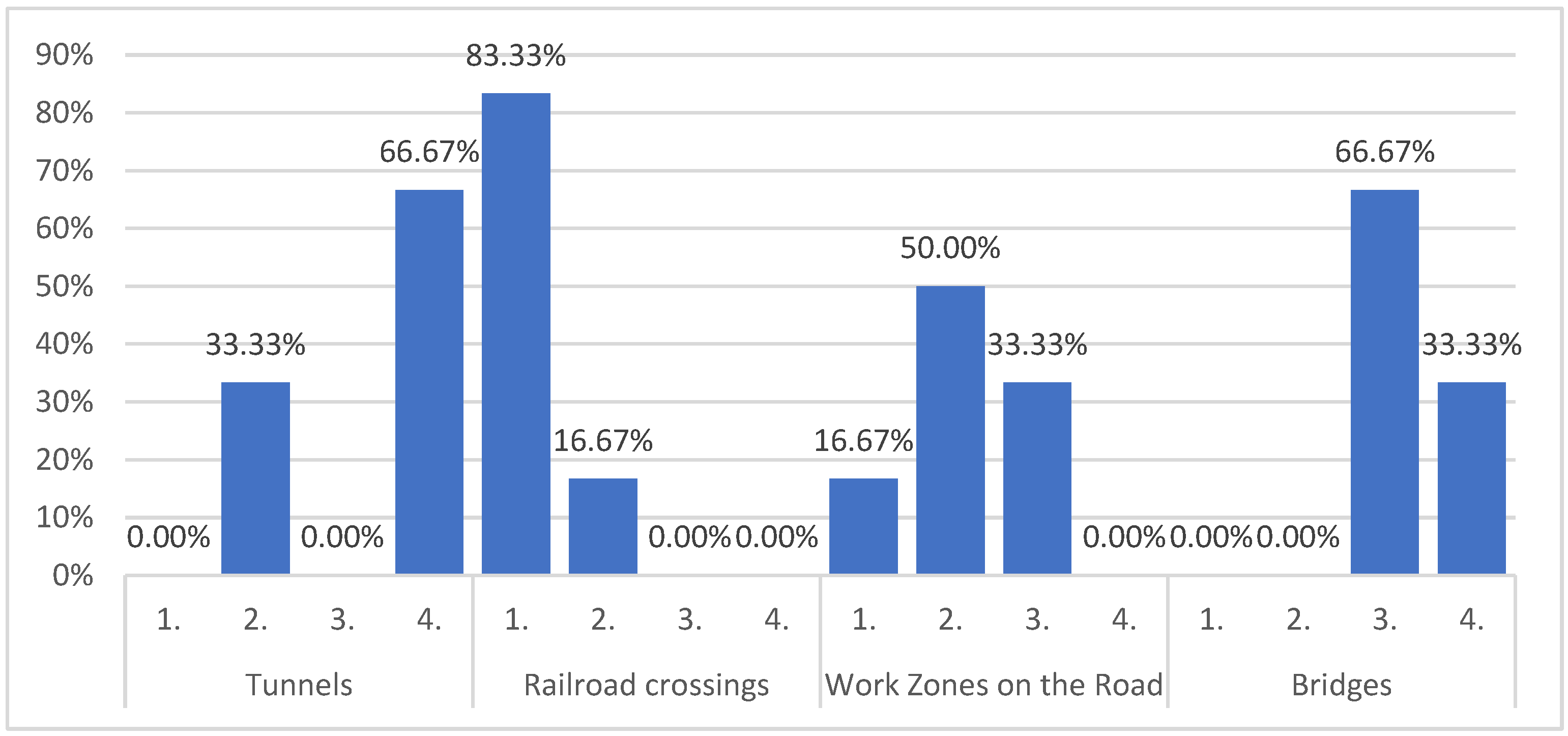A Comprehensive Analysis of Road Crashes at Characteristic Infrastructural Locations: Integrating Data, Expert Assessments, and Artificial Intelligence
Abstract
:1. Introduction
2. Materials and Methods
2.1. Data Collection
2.2. Expert Assessments
2.3. Artificial Intelligence (AI)
2.4. Processing Data
3. Results
3.1. Analysis of Traffic Crashes Data
3.1.1. Bridges
3.1.2. Tunnels
3.1.3. Railroad Crossings
3.1.4. Road Work Zones
3.1.5. Comparison of Road Crashes at Characteristic Infrastructural Locations
3.2. Expert Assessments
3.3. Artificial Intelligence
- -
- Chat GPT
- Railroad crossings: Railroad crossings are particularly dangerous if drivers do not obey warning signs or pay enough attention. Crashes at these locations can be fatal.
- Tunnels: Tunnels pose a challenge due to changes in lighting and possible reduced visibility. Crashes in tunnels can be severe, especially if drivers do not adjust their speed or lose focus.
- Road work zones: Road work zones on the road are often places where crashes occur due to changes in driving conditions and the presence of workers. These zones require extra attention and caution from the driver.
- Bridges: Although bridges are often the site of crashes, I still rank them as the safest of the locations.
- -
- Chat AI
- Railroad crossings: These locations have a higher risk due to the potential for collisions between vehicles and trains, which can lead to severe consequences.
- Road work zones: These areas often have reduced speed limits, lane changes, and construction equipment, making them more prone to crashes.
- Bridges: Bridges can be risky due to limited visibility, narrow lanes, and the potential for ice and snow accumulation, which can affect vehicle control and increase the likelihood of crashes.
- Tunnels: Tunnels can be safer than the other options if well-lit, ventilated, and maintained, but they can also present challenges due to limited visibility, echo effects, and the potential for crashes to be more severe due to confined spaces.
- -
- Chat Gate AI
- Railroad crossings: Often pose significant risks due to the intersection of road and rail.
- Tunnels: Limited visibility and potential for crashes make tunnels relatively risky.
- Road work zones: Changing road conditions and the presence of workers can lead to safety hazards.
- Bridges: While bridges can have their own safety concerns, they are usually more straightforward compared to the other locations listed.
- -
- Gemini
- Railroad crossings: The greatest risk is represented by railroad crossings due to the possibility of collisions with trains. These crossings often have limited visibility and require drivers to come to a complete stop and take extra care.
- Road work zones: These zones are at increased risk due to lane changes, uneven surfaces, merging traffic, and slower speeds. There is also the presence of workers and construction equipment.
- Bridges: Bridges are typically safe as they separate traffic levels. However, factors like high winds, narrow lanes, or congested traffic can increase the risk.
- Tunnels: Generally, tunnels have the safest record. They eliminate interactions with oncoming traffic, pedestrians, and other distractions. They also often have controlled environments with lighting and ventilation.
- -
- Copilot Microsoft
- Railroad crossings: Railroad crossings are the least safe because of the inherent risk of collisions between trains and road vehicles. Trains cannot stop quickly, and collisions can be severe.
- Road work zones: Road work zones pose risks due to ongoing construction activities.
- Bridges: Bridges are generally safe for road users. However, safety depends on factors such as bridge design, maintenance, and adherence to traffic rules.
- Tunnels: Tunnels can be safe if well-designed and maintained.
- -
- DeepAI
- Road work zones: These zones often have reduced speed limits, lane closures, and unpredictable traffic patterns, making them the least safe.
- Railroad crossings: They require drivers to stop and look for approaching trains, which can be difficult if visibility is poor or the train is far away. The risk of crashes with trains is significant.
- Bridges: Bridges may have reduced visibility due to their structure and limited sightlines, especially in poor weather conditions.
- Tunnels: Tunnels generally have better visibility and are well ventilated but can be dangerous due to limited escape routes in the event of a crash or emergency.
3.4. Data–Expert Assessments–AI
4. Conclusions
Author Contributions
Funding
Institutional Review Board Statement
Data Availability Statement
Conflicts of Interest
References
- Mohamed, J.; Mohamed, A.I.; Ali, D.A.; Gebremariam, T.T. Prevalence and factors associated with ever had road crashes among drivers in Hargeisa city, Somaliland, 2022. Heliyon 2023, 9, e18631. [Google Scholar] [CrossRef]
- Pešić, D.; Pešić, D.; Trifunović, A.; Čičević, S. What affects the perception of a drunk driving campaign? Transp. Res. Rec. 2023, 2677, 196–210. [Google Scholar] [CrossRef]
- Glavić, D. The impact of highway construction on the volume and distribution of traffic flows: Case study for highway A2 in Serbia. J. Road Traffic Eng. 2023, 69, 11–17. [Google Scholar] [CrossRef]
- Ivanović, V.; Lindov, O.; Radović, M. Testing and analysis of the elements of the high-risk road section concerning the quality of the pavement curtain and its impact on the value of the adhesion coefficient. J. Road Traffic Eng. 2024, 70, 23–30. [Google Scholar] [CrossRef]
- Çeven, S.; Albayrak, A. Traffic accident severity prediction with ensemble learning methods. Comput. Electr. Eng. 2024, 114, 109101. [Google Scholar] [CrossRef]
- Cui, P.; Yang, X.; Abdel-Aty, M.; Zhang, J.; Yan, X. Advancing urban traffic accident forecasting through sparse spatio-temporal dynamic learning. Accid. Anal. Prev. 2024, 200, 107564. [Google Scholar] [CrossRef] [PubMed]
- Kodepogu, K.; Manjeti, V.B.; Siriki, A.B. Machine Learning for Road Accident Severity Prediction. Mechatron. Intell. Transp. Syst. 2023, 2, 211–226. [Google Scholar] [CrossRef]
- Pantelić, O.; Pešić, D.; Vujanić, M.; Švab, K.; Trifunović, A. Application of the AHP Method for Comparative Analysis of Software Systems in Traffic from the Aspect of Road Safety. Promet-TrafficTransp. 2023, 35, 525–539. [Google Scholar] [CrossRef]
- Vasavi, S.; Sravanthi, G.L.; Ram, B.S.; Gokhale, A.A. Predictive analytics of bridge safety for intelligent transportation system using ensemble model. Mater. Today Proc. 2021, 45, 5608–5616. [Google Scholar] [CrossRef]
- Zhang, J.; Zhu, C.; Ma, C. Driving safety analysis of wind–vehicle–bridge system considering aerodynamic interference. J. Wind Eng. Ind. Aerodyn. 2024, 245, 105649. [Google Scholar] [CrossRef]
- Lu, P.; Pei, S.; Tolliver, D. Regression model evaluation for highway bridge component deterioration using national bridge inventory data. J. Transp. Res. Forum 2016, 55, 5–16. [Google Scholar] [CrossRef]
- Neves, A.C.; González, I.; Leander, J.; Karoumi, R. A new approach to damage detection in bridges using machine learning. In Experimental Vibration Analysis for Civil Structures: Testing, Sensing, Monitoring, and Control; Springer: Berlin/Heidelberg, Germany, 2018; Volume 7, pp. 73–84. [Google Scholar] [CrossRef]
- Zhao, X.; Yang, H.; Yao, Y.; Qi, H.; Guo, M.; Su, Y. Factors affecting traffic risks on bridge sections of freeways based on partial dependence plots. Phys. A Stat. Mech. Appl. 2022, 598, 127343. [Google Scholar] [CrossRef]
- Yang, L.H.; Wang, Y.M.; Chang, L.L.; Fu, Y.G. A disjunctive belief rule-based expert system for bridge risk assessment with dynamic parameter optimization model. Comput. Ind. Eng. 2017, 113, 459–474. [Google Scholar] [CrossRef]
- Luo, Q.; Liu, C. Exploration of road closure time characteristics of tunnel road crashes: A case study in Pennsylvania, USA. Tunn. Undergr. Space Technol. 2023, 132, 104894. [Google Scholar] [CrossRef]
- Pérez-Sala, L.; Curado, M.; Tortosa, L.; Vicent, J.F. Deep learning model of convolutional neural networks powered by a genetic algorithm for prevention of road crashes severity. Chaos Solitons Fractals 2023, 169, 113245. [Google Scholar] [CrossRef]
- Yang, Y.; Zhang, Y.; Zheng, T.; Tian, Q. Research on traffic accident prediction of expressway tunnel based on B-NB model. Traffic Inj. Prev. 2024, 25, 527–536. [Google Scholar] [CrossRef]
- Ahmed, J.; Robinson, A.; Miller, E.E. Effectiveness of signs for pedestrian-railroad crossings: Colors, shapes, and messaging strategies. J. Saf. Res. 2024, 89, 141–151. [Google Scholar] [CrossRef]
- Benekohal, R.F.; Mathew, J. Railroad Safety: Grade Crossings and Trespassing. In International Encyclopedia of Transportation; Elsevier: Amsterdam, The Netherlands, 2021; Volume 1–7, pp. 466–476. [Google Scholar] [CrossRef]
- Guo, F.; Wang, Y.; Qian, Y. Computer vision-based approach for smart traffic condition assessment at the railroad grade crossing. Adv. Eng. Inform. 2022, 51, 101456. [Google Scholar] [CrossRef]
- Mathew, J.; Benekohal, R.F. Highway-rail grade crossings accident prediction using Zero Inflated Negative Binomial and Empirical Bayes method. J. Saf. Res. 2021, 79, 211–236. [Google Scholar] [CrossRef]
- NSC Injury Facts. Available online: https://injuryfacts.nsc.org/motor-vehicle/motor-vehicle-safety-issues/work-zones/ (accessed on 16 April 2024).
- Work Zone Barriers. Available online: https://www.workzonebarriers.com/work-zone-crash-facts.html (accessed on 16 April 2024).
- Vivas Pacheco, H.; Rodríguez-Mariaca, D.; Jaramillo, C.; Fandiño-Losada, A.; Gutiérrez-Martínez, M.I. Traffic fatalities and urban infrastructure: A spatial variability study using geographically weighted Poisson regression applied in Cali (Colombia). Safety 2023, 9, 34. [Google Scholar] [CrossRef]
- Karamanlis, I.; Kokkalis, A.; Profillidis, V.; Botzoris, G.; Kiourt, C.; Sevetlidis, V.; Pavlidis, G. Deep Learning-Based Black Spot Identification on Greek Road Networks. Data 2023, 8, 110. [Google Scholar] [CrossRef]
- Mendes OB, B.; Larocca AP, C.; Rodrigues Silva, K.; Pirdavani, A. Assessing the Performance of Highway Safety Manual (HSM) Predictive Models for Brazilian Multilane Highways. Sustainability 2023, 15, 10474. [Google Scholar] [CrossRef]
- Le, K.G.; Tran, Q.H.; Do, V.M. Urban Traffic Accident Features Investigation to Improve Urban Transportation Infrastructure Sustainability by Integrating GIS and Data Mining Techniques. Sustainability 2023, 16, 107. [Google Scholar] [CrossRef]
- Chen, J.; Xiong, P.; Li, K.; Yang, S. Optimization Study of Fire Prevention Structure of Electric Vehicle Based on Bottom Crash Protection. Fire 2024, 7, 209. [Google Scholar] [CrossRef]
- Amin, M.; Ullah, K.; Asif, M.; Shah, H.; Mehmood, A.; Khan, M.A. Real-world driver stress recognition and diagnosis based on multimodal deep learning and fuzzy EDAS approaches. Diagnostics 2023, 13, 1897. [Google Scholar] [CrossRef]
- Kovacevic, J.; Fotez, I.; Miskulin, I.; Lesic, D.; Miskulin, M.; Berlancic, T.; Vukoja, I.; Candrlic, S.; Palenkic, H.; Candrlic, M. Different patterns of mental health outcomes among road traffic crash survivors: A prospective cohort study. Int. J. Environ. Res. Public Health 2021, 18, 1564. [Google Scholar] [CrossRef]
- Bridgelall, R. Driving standardization in infrastructure monitoring: A role for connected vehicles. Vehicles 2023, 5, 1878–1891. [Google Scholar] [CrossRef]
- Niu, C.; Song, Y.; Zhao, X. SE-Lightweight YOLO: Higher Accuracy in YOLO Detection for Vehicle Inspection. Appl. Sci. 2023, 13, 13052. [Google Scholar] [CrossRef]
- Road Safety Agency. Available online: https://www.abs.gov.rs/rsc (accessed on 16 April 2024).
- Alfredo, R.; Echeverria, V.; Jin, Y.; Yan, L.; Swiecki, Z.; Gašević, D.; Martinez-Maldonado, R. Human-Centered Learning Analytics and AI in Education: A Systematic Literature Review. Comput. Educ. Artif. Intell. 2024, 6, 100215. [Google Scholar] [CrossRef]
- Ifelebuegu, A.O.; Kulume, P.; Cherukut, P. Chatbots and AI in Education (AIEd) tools: The good, the bad, and the ugly. J. Appl. Learn. Teach. 2023, 6, 332–345. [Google Scholar] [CrossRef]
- Public Enterprise—Roads of Serbia. Available online: https://www.putevi-srbije.rs/index.php/en/about-us (accessed on 16 April 2024).
- Road Safety Agency. Available online: https://www.abs.gov.rs/en/statistika/baza_podataka (accessed on 16 April 2024).
- Obradovic, M.; Jevremović, S.; Trpković, A.; Milosavljević, M. Traffic-spatial analysis of road-rail crossings on state roads in the Republic of Serbia. J. Road Traffic Eng. 2020, 66, 35–40. [Google Scholar] [CrossRef]
- Wu, C.; Kao, S.C.; Chang, C.C. A knowledge elicitation approach to road crashes analysis in open data: Comparing periods before and after the COVID-19 outbreak. Heliyon 2022, 8, e10302. [Google Scholar] [CrossRef]
- Krstić, M.; Tadić, S.; Brnjac, N. Strategic Application of Industry 4.0 Technologies in Enhancing Intermodal Transport Terminal Efficiency. J. Organ. Technol. Entrep. 2023, 1, 98–109. [Google Scholar] [CrossRef]
- Krstić, M.; Tadić, S.; Jolović, M. Evaluation of Transshipment Technologies in Intermodal Terminals: A Hybrid FSWARA-ADAM Approach. J. Organ. Technol. Entrep. 2024, 2, 27–38. [Google Scholar] [CrossRef]
- Pajić, V.; Andrejić, M.; Chatterjee, P. Enhancing Cold Chain Logistics: A Framework for Advanced Temperature Monitoring in Transportation and Storage. Mechatron. Intell. Transp. Syst. 2024, 3, 16–30. [Google Scholar] [CrossRef]
- Trifunović, A.; Senić, A.; Čičević, S.; Ivanišević, T.; Vukšić, V.; Simović, S. Evaluating the Road Environment Through the Lens of Professional Drivers: A Road Safety Perspective. Mechatron. Intell. Transp. Syst. 2024, 3, 31–38. [Google Scholar] [CrossRef]
- Ivanišević, T.; Ivković, I.; Čičevic, S.; Trifunović, A.; Pešić, D.; Vukšić, V.; Simović, S. The impact of daytime running (LED) lights on motorcycles speed estimation: A driving simulator study. Transp. Res. Part F Traffic Psychol. Behav 2022, 90, 47–57. [Google Scholar] [CrossRef]







| Bridges | Tunnels | Railroad Crossings | ||||||||||
|---|---|---|---|---|---|---|---|---|---|---|---|---|
| F * | I * | P * | T * | F * | I * | P * | T * | F * | I * | P * | T * | |
| 2018 | 0.03 | 1.21 | 1.84 | 3.08 | 0.00 | 0.44 | 0.53 | 0.97 | 0.00 | 0.08 | 1.07 | 1.15 |
| 2019 | 0.06 | 1.29 | 1.73 | 3.08 | 0.06 | 0.38 | 0.69 | 1.13 | 0.00 | 0.32 | 1.31 | 1.62 |
| 2020 | 0.07 | 1.05 | 1.39 | 2.51 | 0.00 | 0.31 | 0.53 | 0.85 | 0.04 | 0.16 | 0.91 | 1.11 |
| 2021 | 0.09 | 1.12 | 1.54 | 2.75 | 0.06 | 0.35 | 0.60 | 1.01 | 0.00 | 0.36 | 1.86 | 2.22 |
| 2022 | 0.07 | 0.92 | 1.36 | 2.36 | 0.00 | 0.31 | 0.47 | 0.79 | 0.08 | 0.40 | 1.70 | 2.18 |
| Fatal | Injuries | Property Damage | Total | |
|---|---|---|---|---|
| 2018 | 0.0051 | 0.1428 | 0.2248 | 0.3727 |
| 2019 | 0.0051 | 0.1429 | 0.2237 | 0.3717 |
| 2020 | 0.0047 | 0.1232 | 0.1915 | 0.3194 |
| 2021 | 0.0049 | 0.1380 | 0.2162 | 0.3591 |
| 2022 | 0.0052 | 0.1329 | 0.2077 | 0.3458 |
| Artificial Intelligence Tool | Ranking of Characteristic Infrastructural Locations (from the Most Unsafe to the Safest) |
|---|---|
| 1. Railroad crossings 2. Tunnels 3. Road work zones 4. Bridges |
| 1. Railroad crossings 2. Road work zones 3. Bridges 4. Tunnels |
| 1. Railroad crossings 2. Tunnels 3. Road work zones 4. Bridges |
| 1. Railroad crossings 2. Road work zones 3. Bridges 4. Tunnels |
| 1. Railroad crossings 2. Road work zones 3. Bridges 4. Tunnels |
| 1. Road work zones 2. Railroad crossings 3. Bridges 4. Tunnels |
| Evaluation Method | Data | Experts Assessments | Artificial Intelligence Tool |
|---|---|---|---|
| Ranking of characteristic infrastructural locations (from the most unsafe to the safest) | 1. Bridges 2. Road work zones 3. Railroad crossings 4. Tunnels | 1. Bridges 2. Road work zones 3. Railroad crossings 4. Tunnels | 1. Railroad crossings 2. Road work zones 3. Tunnels 4. Bridges |
Disclaimer/Publisher’s Note: The statements, opinions and data contained in all publications are solely those of the individual author(s) and contributor(s) and not of MDPI and/or the editor(s). MDPI and/or the editor(s) disclaim responsibility for any injury to people or property resulting from any ideas, methods, instructions or products referred to in the content. |
© 2024 by the authors. Licensee MDPI, Basel, Switzerland. This article is an open access article distributed under the terms and conditions of the Creative Commons Attribution (CC BY) license (https://creativecommons.org/licenses/by/4.0/).
Share and Cite
Ivanišević, T.; Vujanić, M.; Senić, A.; Trifunović, A.; Čičević, S. A Comprehensive Analysis of Road Crashes at Characteristic Infrastructural Locations: Integrating Data, Expert Assessments, and Artificial Intelligence. Infrastructures 2024, 9, 134. https://doi.org/10.3390/infrastructures9080134
Ivanišević T, Vujanić M, Senić A, Trifunović A, Čičević S. A Comprehensive Analysis of Road Crashes at Characteristic Infrastructural Locations: Integrating Data, Expert Assessments, and Artificial Intelligence. Infrastructures. 2024; 9(8):134. https://doi.org/10.3390/infrastructures9080134
Chicago/Turabian StyleIvanišević, Tijana, Milan Vujanić, Aleksandar Senić, Aleksandar Trifunović, and Svetlana Čičević. 2024. "A Comprehensive Analysis of Road Crashes at Characteristic Infrastructural Locations: Integrating Data, Expert Assessments, and Artificial Intelligence" Infrastructures 9, no. 8: 134. https://doi.org/10.3390/infrastructures9080134
APA StyleIvanišević, T., Vujanić, M., Senić, A., Trifunović, A., & Čičević, S. (2024). A Comprehensive Analysis of Road Crashes at Characteristic Infrastructural Locations: Integrating Data, Expert Assessments, and Artificial Intelligence. Infrastructures, 9(8), 134. https://doi.org/10.3390/infrastructures9080134








